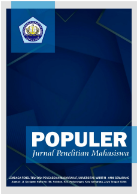Model Indeks Kekuatan Negara dengan Regresi Beta: Analisis Pengaruh Stabilitas Ekonomi, Demografi, dan Infrastruktur Teknologi Terhadap Kemampuan Pertahanan dan Keamanan
DOI:
https://doi.org/10.58192/populer.v4i1.3005Keywords:
Power Index, Economic Stability, Military Technology, Beta RegressionAbstract
Power Index is a strategic indicator measuring a nation's military, economic, and geopolitical capabilities, closely tied to national defense and security. This study examines key factors such as currency exchange rates, GDP, education levels, and technology penetration in shaping the Power Index. Economic stability underpins defense development, while advanced education and digital infrastructure drive innovations in military technology and cybersecurity. Developed countries dominate defense capabilities due to robust technological infrastructures, while developing nations show potential through investments in education and technology. Beta distribution regression, with its suitability for bounded variables, was utilized to model the Power Index. The study provides insights into the interplay between economic, educational, and technological factors, supporting strategic policymaking to strengthen national defense in a dynamic global landscape.
References
AbouRizk, S. M., Halpin, D. W., & Wilson, J. R. (1994). Fitting beta distributions based on sample data. Journal of Construction Engineering and Management, 120(2), 288–305. https://doi.org/10.1061/(ASCE)0733-9364(1994)120:2(288).
Arnesen, C. M., Grinstein, B., Rothstein, I. Z., & Stewart, I. W. (2005). Precision model independent determination of ∣V_ub∣ from B→πlν. Physical Review Letters, 95(7), 071802. https://doi.org/10.1103/PhysRevLett.95.071802.
Bachrach, Y., Markakis, E., Resnick, E., & Rosenschein, J. S. (2010). Approximating power indices: Theoretical and empirical analysis. Autonomous Agents and Multi-Agent Systems, 20(1), 105–122. https://doi.org/10.1007/s10458-009-9078-9.
Blocher, E. and Chow, C.W. (1988), "The Power Index: A Tool for Achieving Proper Representation on Key Management Committees", American Journal of Business, Vol. 3 No. 1, pp. 53-58. https://doi.org/10.1108/19355181198800009.
Franceschini, G., & Macchietto, S. (2008). Model-based design of experiments for parameter precision: State of the art. Chemical Engineering Science, 63(19), 4846–4872. https://doi.org/10.1016/j.ces.2007.11.034.
Garrett, G., & Tsebelis, G. (1999). More reasons to resist the temptation of power indices in the European Union. Journal of Theoretical Politics, 11(3), 331–338. https://doi.org/10.1177/0951692899011003004.
Ginting, E. D. B., & Sutarman. (2023). Penaksiran parameter regresi Poisson dengan maximum likelihood. IJM: Indonesian Journal of Multidisciplinary, 1(6). Retrieved from https://journal.csspublishing.com/index.php/ijm/article/view/513.
Hidayatullah, I. (2019). Peran pemerintah dalam stabilitas ekonomi pasar. Iqtishoduna: Jurnal Ekonomi Islam, 8(1), 183–208.
Jambunathan, M. V. (1954). Some properties of beta and gamma distributions. The Annals of Mathematical Statistics, 25(2), 401–405. http://www.jstor.org/stable/2236745.
Kennedy, P. S. J. (2016). Menghitung indeks kekuatan nasional. Buletin Ekonomi, 20(2), 56–65. https://doi.org/10.33541/buletin%20ekonomi.v20i2.573.
Kurniawan, P. S. (2018). Maximum likelihood estimator untuk mengestimasi model regresi isotonik dengan pendekatan polinomial Bernstein pada kasus satu variabel independen.
Maisharoh, T., & Ali, H. (2020). Faktor-faktor yang mempengaruhi infrastruktur teknologi informasi: Keuangan, fleksibilitas TI, dan kinerja organisasi. Universitas Mercu Bauna (UMB) Jakarta, 1–9.
Maryati, S. (2015). Dinamika pengangguran terdidik: Tantangan menuju bonus demografi di Indonesia. Economica: Journal of Economic and Economic Education, 3(2), 124–136. https://doi.org/10.22202/economica.2015.v3.i2.249.
McDonald, J. B., & Xu, Y. J. (1995). A generalization of the beta distribution with applications. Journal of Econometrics, 66(1–2), 133–152. https://doi.org/10.1016/0304-4076(94)01612-4.
Misbahussurur, A. (2009). Estimasi parameter distribusi Gamma dengan metode maksimum likelihood (Doctoral dissertation, Universitas Islam Negeri Maulana Malik Ibrahim).
Ridiani, F. (2016). Pendugaan parameter distribusi beta dengan metode momen dan metode maksimum likelihood. Jurnal Matematika UNAND, 3(2), 23–28.
Vansteelandt, S., & Goetghebeur, E. (2003). Causal inference with generalized structural mean models. Journal of the Royal Statistical Society: Series B (Statistical Methodology), 65(4), 817–835. https://doi.org/10.1046/j.1369-7412.2003.00417.x.
Verkuilen, J., & Smithson, M. (2012). Mixed and mixture regression models for continuous bounded responses using the beta distribution. Journal of Educational and Behavioral Statistics, 37(1), 82–113. https://doi.org/10.3102/1076998610396895.
Warella, R., Wattimanela, H., & Ilwaru, V. Y. (2021). Sifat-sifat dan kejadian khusus distribusi gamma. BAREKENG: Jurnal Ilmu Matematika Dan Terapan, 15(1), 047–058. https://doi.org/10.30598/barekengvol15iss1pp047-058.
Zhang, C., & Wu, R. (2019). Battlefield of global ranking: How do power rivalries shape soft power index building? Global Media and China, 4(2), 179–202. https://doi.org/10.1177/2059436419855876.









